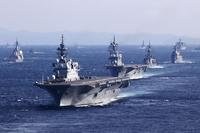 Despite years of effort by U.S. trainers, the fledgling Afghan Air Force still lacks the planes and the pilots to bomb and strafe in support of its own ground forces and won’t have that ability anytime soon, the top U.S. air commander in Afghanistan said Tuesday.
Despite years of effort by U.S. trainers, the fledgling Afghan Air Force still lacks the planes and the pilots to bomb and strafe in support of its own ground forces and won’t have that ability anytime soon, the top U.S. air commander in Afghanistan said Tuesday.
“They don’t,” Air Force Maj. Gen. H.D. “Jake” Polumbo said when asked if the AAF had the ability to back up the Afghan army in combat. “They have no close air support capability as we would define it. It will take time,” said Polumbo, director of the air component of the International Security Assistance Force.
In a video briefing to the Pentagon from Kabul, Polumbo said that the AAF should begin getting attack aircraft sometime in 2014 with the hoped for arrival of the first of 20 Embraer A29B Super Tucano light air support prop planes which the U.S. bought for the AAF for $427 million.
But that timetable assumes that the Super Tucanos will survive another challenge for the contract from Beechcraft (formerly Hawker Beechcraft), maker of the competing AT-6B Texan II prop plane. The General Accountability Office is currently reviewing the viability of the Beechcraft challenge, and another round of lawsuits was a possibility.
Kansas lawmakers are backing the challenge from Kansas-based Beechcraft while Florida and Ohio politicians are rallying round the Super Tucano, which would be assembled in Jacksonville, Fla., with avionics made by the Sierra Nevada Corp. at a plant in Centennial, Ohio.
And even assuming that the Super Tucanos arrive on time, there is still the problem of finding Afghans who can be trained to fly them.
Afghans who have been showing up for training in the Afghan Air Force couldn’t read and write, Polumbo said, and an entire class had to be sent home recently because they were illiterate. Flying the Super Tucano “requires English and full literacy capabilities,” Polumbo said.
“Building the AAF from the ground up is no easy task,” said Polumbo, echoing the sentiments of his predecessor as air commander, Maj. Gen. Todd Wolters.
The AAF currently has about 6,000 personnel in the projected overall force of 352,000 soldiers and police in the Afghan National Security Forces (ANSF), but Polumbo said the “early signs are encouraging” for the new Afghan airmen.
The AAF currently is flying aging Russian-made Mi-17 and Mi-35 helicopters but adding the fixed-wing ability to support ground troops was vital as NATO forces withdraw all combat troops by the end of 2014, Polumbo said. “We know that (tactical) air is a critical enabler,” said Polumbo, who doubles as commander of the 9th Air and Space Expeditionary Task Force-Afghanistan. “The Taliban have no match for it.”
The Afghans and the remaining NATO forces will have to rely for close air support on U.S. and allied fixed-wing aircraft. As the troops withdraw, the air support will increasingly come from “over the horizon” from U.S. carriers in the Persian Gulf and Gulf airbases, Polumbo said.
When the troops are withdrawn, the focus of the air war in Afghanistan will shift to drones for tactical air and reconnaissance, Polumbo said.
“I come back to the remotely piloted aircraft,” Polumbo said. “They can collect intelligence, but they also are armed. And they’re armed to be able to provide force protection to our coalition forces and then when our coalition ground force commanders, when they deem it appropriate, they can control that air-delivered munition capability from the RPAs to be put in support of the Afghans.”







